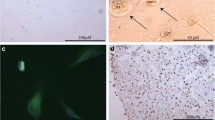Abstract.
In several aspects the features of aging resemble those of the state of growth hormone (GH) deficiency. Alterations of bone density and increased incidence of osteoporosis are some of the characteristics of aging that are similar to the findings in GH-deficient adults. Osteoarthritis (OA), a nonfatal condition predominating in old age, is characterized by the slowly progressive destruction of articular cartilage of joints. OA lesions are observed in the temporomandibular joint of ICR mice aged 7 months and older. The aim of the present study was to compare the response of chondrocytes from mandibular condyle cartilage of young and old mice to GH and to ascertain whether chondrocytes of old animals could still be stimulated to proliferate and to synthesize matrix components under the direct effect of GH in vitro. Mandibular condyles from young (3-month-old) and old (20-month-old) female ICR mice were cultured up to 72 hours in the presence of recombinant rat GH (0.1–100 ng/ml). 3H-Thymidine and 35S-sulfate were introduced during the last 24 hours of culture. Administration of GH appeared to increase only slightly the incorporation of 3H-thymidine in cartilage from young compared with the response in cartilage from old animals which was much more significant at 24 hours and 48 hours in culture. The same pattern was seen for the effect of GH on the incorporation of 35S-sulfate. Cartilage from young animals responded only slightly to GH, whereas a significant response was observed in cartilage from old animals after 24 and 48 hours in vitro. DNA contents were significantly elevated at all time intervals in both old and young animals, yet more significantly in cultures from old animals. In contrast, the activities of both alkaline and acid phosphatases were elevated at all time intervals in cultures from young animals, whereas no induction was observed in cultures from old animals. Tissue sections from cultures of old animals treated with GH (10 ng/ml, 48 hours) revealed atypical hypertrophic cells along the articular surface and also dark staining along the cartilage-bone interface. Exposure to tetracycline (10 mg/ml, 24 hours) resulted in an induced fluorescence, indicating enhanced mineralization in this region. Results of this study indicate that mandibular condyle cartilage from OA old mice responds in vitro to the addition of GH via anabolic activities of cell proliferation, sulfated proteoglycan synthesis, and possibly enhanced mineralization.
Similar content being viewed by others
Author information
Authors and Affiliations
Additional information
Received: 29 March 1996 / Accepted: 31 December 1996
Rights and permissions
About this article
Cite this article
Livne, E., Laufer, D. & Blumenfeld, I. Comparison of In Vitro Response to Growth Hormone by Chondrocytes from Mandibular Condyle Cartilage of Young and Old Mice. Calcif Tissue Int 61, 62–67 (1997). https://doi.org/10.1007/s002239900296
Published:
Issue Date:
DOI: https://doi.org/10.1007/s002239900296




